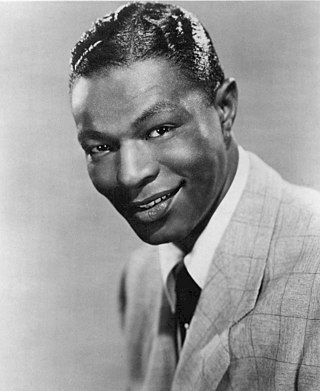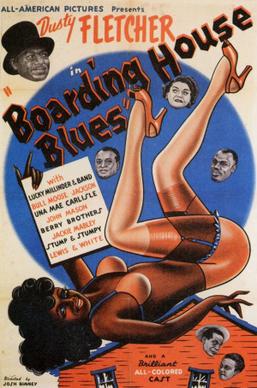
Nathaniel Adams Coles, known professionally by his stage name Nat King Cole, was an American singer, jazz pianist, and actor. Cole's career as a jazz and pop vocalist started in the late 1930s and spanned almost three decades where he found success and recorded over 100 songs that became hits on the pop charts.

Joe Williams was an American jazz singer. He sang with big bands, such as the Count Basie Orchestra and the Lionel Hampton Orchestra, and with small combos. He sang in two films with the Basie orchestra and sometimes worked as an actor.

Harry "Sweets" Edison was an American jazz trumpeter and a member of the Count Basie Orchestra. His most important contribution was as a Hollywood studio musician, whose muted trumpet can be heard backing singers, most notably Frank Sinatra.
The swing era was the period (1933–1947) when big band swing music was the most popular music in the United States. Though this was its most popular period, the music had actually been around since the late 1920s and early 1930s, being played by black bands led by such artists as Duke Ellington, Jimmie Lunceford, Bennie Moten, Cab Calloway, Earl Hines, and Fletcher Henderson, and white bands from the 1920s led by the likes of Jean Goldkette, Russ Morgan and Isham Jones. An early milestone in the era was from "the King of Swing" Benny Goodman's performance at the Palomar Ballroom in Los Angeles on August 21, 1935, bringing the music to the rest of the country. The 1930s also became the era of other great soloists: the tenor saxophonists Coleman Hawkins, Ben Webster and Lester Young; the alto saxophonists Benny Carter and Johnny Hodges; the drummers Chick Webb, Gene Krupa, Jo Jones and Sid Catlett; the pianists Fats Waller and Teddy Wilson; the trumpeters Louis Armstrong, Roy Eldridge, Bunny Berigan, and Rex Stewart.
John Alfred Mandel was an American composer and arranger of popular songs, film music and jazz. The musicians he worked with include Count Basie, Frank Sinatra, Peggy Lee, Anita O'Day, Barbra Streisand, Tony Bennett, Diane Schuur and Shirley Horn. He won five Grammy Awards, from 17 nominations; his first nomination was for his debut film score for the multi-nominated 1958 film I Want to Live!

Loretta Mary Aiken, known by her stage name Jackie "Moms" Mabley, was an American stand-up comedian and actress. Mabley began her career on the theater stage in the 1920s and became a veteran entertainer of the Chitlin' Circuit of black vaudeville. Mabley later recorded comedy albums and appeared in films and on television programs including The Ed Sullivan Show and The Smothers Brothers Comedy Hour.

Lester Willis Young, nicknamed "Pres" or "Prez", was an American jazz tenor saxophonist and occasional clarinetist.
"Do Nothing till You Hear from Me" is a song with music by Duke Ellington and lyrics by Bob Russell. It originated as a 1940 instrumental that was designed to highlight the playing of Ellington's lead trumpeter, Cootie Williams. Russell's words were added later. In 1944, Ellington's own recording of the song was a number one hit R&B chart for eight non-consecutive weeks and number six on the pop chart.

The Count Basie Orchestra is a 16- to 18-piece big band, one of the most prominent jazz performing groups of the swing era, founded by Count Basie in 1935 and recording regularly from 1936. Despite a brief disbandment at the beginning of the 1950s, the band survived long past the big band era itself and the death of Basie in 1984. It continues under the direction of trumpeter Scotty Barnhart.
"Too Marvelous for Words" is a popular song written in 1937. Johnny Mercer wrote the lyrics for music composed by Richard Whiting. It was introduced by Wini Shaw and Ross Alexander in the 1937 Warner Brothers film Ready, Willing, and Able, as well as used for a production number in a musical revue on Broadway. The song has become a pop and jazz standard and has been recorded by many artists.
"I've Grown Accustomed to Her Face" is a song from the 1956 musical My Fair Lady, with music by Frederick Loewe and lyrics by Alan Jay Lerner. It was originally performed by Rex Harrison as Professor Henry Higgins who also performed it in the 1964 film version.
"Let's Face the Music and Dance" is a song published in 1936 by Irving Berlin for the film Follow the Fleet, where it was introduced by Fred Astaire and featured in a celebrated dance duet with Astaire and Ginger Rogers. The jazz song has also been covered by various artists years following its release, including Nat King Cole, Ella Fitzgerald, Frank Sinatra, Mel Torme, Todd Gordon and others.

That's Black Entertainment is a 1989 documentary film starring African-American performers and featuring clips from black films from 1929–1957, narrated and directed by William Greaves. The clips are from the Black Cinema Collection of the Southwest Film/Video Archives at Southern Methodist University in Dallas, Texas. It is 60 minutes long and was distributed by Video Communications of Tulsa, Oklahoma.
"A Cottage for Sale" is a popular song. The music was composed by Willard Robison, and the lyrics were written by Larry Conley. The song was first published in 1929, and over 100 performers have recorded versions of "A Cottage for Sale." The first versions of the song were released by The Revelers in January 1930 and Bernie Cummins with the New Yorker Orchestra in March 1930.
"Honeysuckle Rose" is a 1929 song composed by Thomas "Fats" Waller with lyrics by Andy Razaf. It was introduced in the 1929 Off-Broadway revue "Load of Coal" at Connie's Inn as a soft-shoe dance number. Waller's 1934 recording was inducted into the Grammy Hall of Fame in 1999.
The Congaroos was a dance group created in 1947 by Frankie Manning after completing his military service for World War II. The group originally consisted of Frankie Manning dancing with Ann Johnson and Russell Williams dancing with Willamae Ricker. Later Helen Daniels joined the group and partnered Frankie Manning. The group performed Lindy Hop, Conga, jazz dance, tap dance, Latin dances, and comedy with musicians and vocalists such as Alvino Rey, Lucky Millinder, Illinois Jacquet, Ella Fitzgerald, Count Basie, Erskine Hawkins, Andy Kirk, Fletcher Henderson, and Cab Calloway.
"I Got It Bad (and That Ain't Good)" is a pop and jazz standard with music by Duke Ellington and lyrics by Paul Francis Webster published in 1941. It was introduced in the musical revue Jump for Joy by Ivie Anderson, who also provided the vocals for Duke Ellington and His Orchestra on the single Victor 27531. Recordings to reach the Billboard charts in 1941/42 were by Duke Ellington (#13) and by Benny Goodman (vocal by Peggy Lee) (#25).

Boarding House Blues is a 1948 American musical race film directed by Josh Binney which featured the first starring film role by Moms Mabley. It was the penultimate feature film of All-American News, a company that made newsreels for black Americans.
Gene Orloff was an American violinist, concertmaster, arranger, contractor and session musician.
Azure-Te is a blues ballad written in 1952 by lyricist Donald E. Wolf for a Wild Bill Davis tune that reached number 30 on the Billboard Hot 100 chart in September 1952 when covered by Frank Sinatra.








